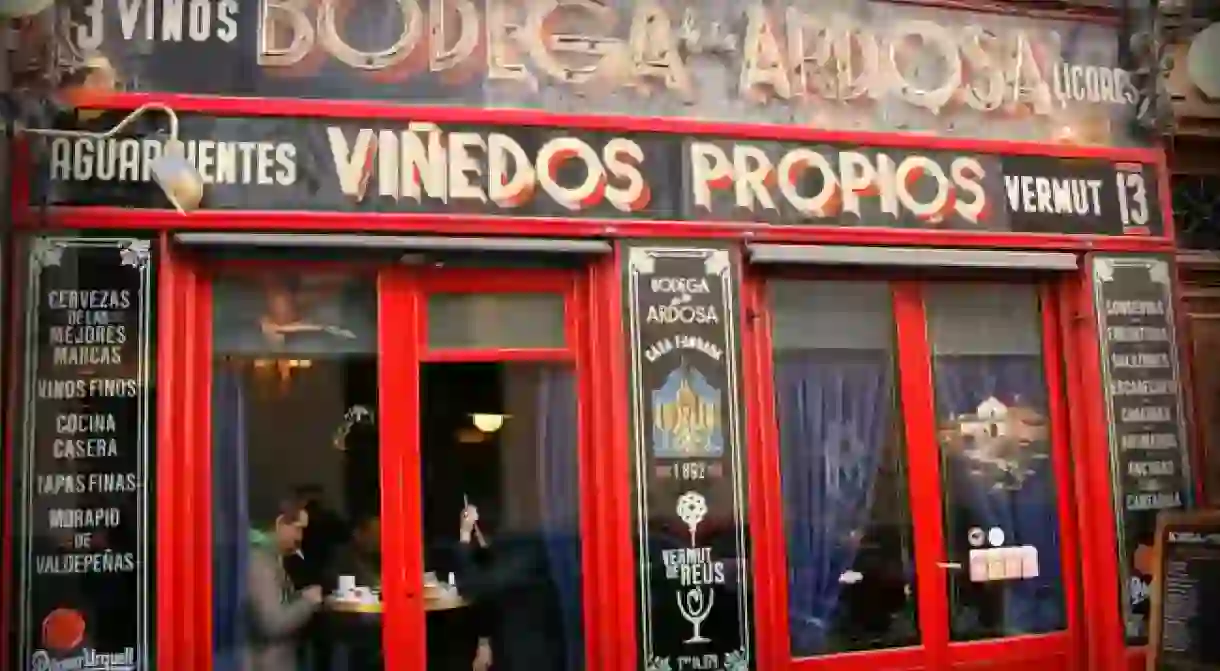The Most Historic Bars in Madrid

One of the best things about Madrid is that the city has managed to preserve many of its old bars, restaurants and shops. Unlike many other big cities around the world, in Madrid you could easily end up having a drink in a bar that has been going strong for well over a century. We take a look at some of the most historic bars to visit the next time you’re in Madrid.
Taberna la Dolores
Bar, Spanish

This bar stands out in Madrid’s Barrio de Las Letras (Literary Quarter) for its tiled façade, a white and blue pattern with bright green grapes and the year the bar opened: 1908. Inside is like a time capsule; the shelves are packed with old beer tankards, the wooden bar is unchanged and even the waiters seem to come from a different age altogether. It gets busy before lunchtime, especially on weekends, when people enjoy a vermouth, a typical local aperitif.
Bodega la Ardosa
Bar, Pub, Restaurant, Bodega, Spanish, Tapas, Wine, Beer

This popular Malasaña spot was founded in 1892 and inside, its wood-panelled bar area looks like it has barely changed in the intervening 126 years. Grab a spot at a high, wooden table and try a caña (small draft beer) or a vermouth, along with a slice of tortilla de patatas, widely considered to be one of the best in Madrid. It can get very busy at weekends, so don’t be over polite, elbow your way inside and enjoy the lively atmosphere.
Cervecería Alemana
Bar, Restaurant, Spanish

On the pretty Plaza Santa Ana, Cervecería Alemana was once the favourite watering hole of Ernest Hemingway (today, there is a picture of the famous writer above his favourite window seat). Opened in 1904 by a group of German manufacturers as somewhere to sample great beer, the bar quickly became a local favourite. With its marble-topped tables, wooden beams and waiters in smart white coats and black bow ties, it is full of character, and a great place to enjoy an ice cold beer and some classic tapas dishes.
La Venencia
Bar, Spanish

Much has been written about this old sherry bar, but despite its position on many tourist itineraries these days, it is still very much worth a visit. Another Hemingway favourite, it served as a meeting point for Republicans during the Spanish Civil War – it was here Hemingway would get the latest news from the front. Sherry is served from huge wooden casks behind the bar and your bill is written on the bar top in chalk. Since it opened, taking photographs has been strictly forbidden – you never knew who was a fascist spy in disguise, after all.
Taberna Antonio Sánchez
Restaurant, Spanish

This dark wood bar, on a side street just off Plaza Tirso de Molina, was opened in 1830 and in the 1880s, was bought by Antonio Sánchez, the father of the bullfighter of the same name. The bar is something of a homage to the tradition, with bulls’ heads and framed photos of famous bullfighters lining the wall. It is famous for its torrijas, a Spanish-style of French toast, popular at Easter. Prop up the bar or take a seat and sample some local tapas dishes like meatballs, tortilla de patatas and patatas bravas.
Casa Amadeo los Caracoles
Bar, Restaurant, Spanish

It might be the French who are known for their love of snails, but Spaniards are quite partial to a shelled creature, too. Los Caracoles (The Snails) has a prime position on the main drag of the Rastro, Madrid’s biggest street market held every Sunday. The bar was opened in 1942 and has been cooking up snails in a spicy sauce in a huge pan behind the bar ever since. The bar does other local delicacies like callos (tripe), pig’s ear and chorizo.
Restaurante Casa Alberto
Bar, Restaurant, Spanish

One of Madrid’s oldest taverns, Casa Alberto was founded in 1827 in the Barrio de Las Letras (Literary Quarter). Its literary credentials are top notch; Miguel de Cervantes is said to have lived in the building and worked on Don Quixote here. Inside, there’s a marble-topped bar, wooden columns and tables and the walls are covered in old pictures. Try a vermouth on tap, sit in the front bar area and soak up the historic atmosphere.













